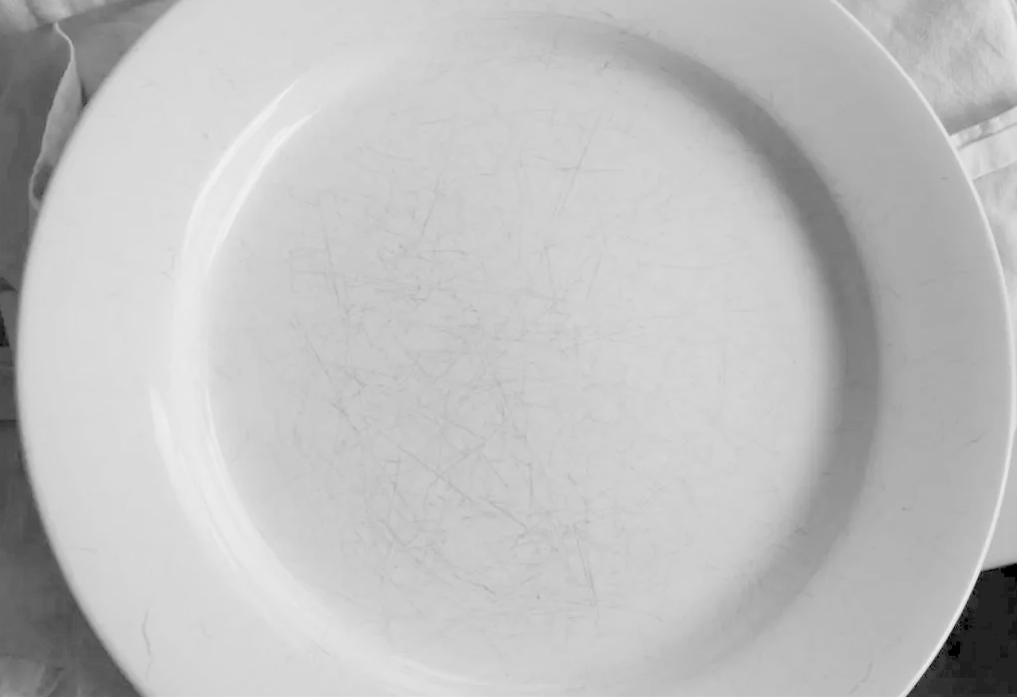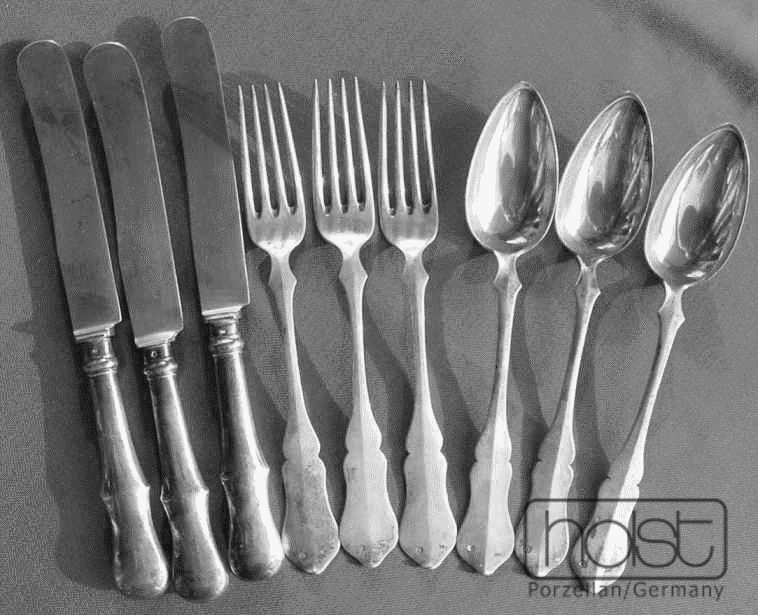Cutlery abrasion
Cutlery abrasion on ceramic surfaces
Definition of cutlery abrasion on porcelain and ceramic glazes
Cutlery abrasion occurs when microscopically small pieces of cutlery rub off on the hard porcelain glaze due to mechanical friction under the influence of pressure, leaving grey to black lines and obvious scratches after repeated use. The glaze of genuine feldspar porcelain has a hardness of 5 to 7 and, according to Mohs' rule, scratches all materials with a hardness of 1 to 6, including chrome steel cutlery, which generally has a hardness of 3 - 4. The damage pattern of cutlery abrasion is primarily observed on flat dinner plates and platters, which are exposed to high mechanical stress due to the use of blunt knife blades. In other words, genuine hard porcelain should not be damaged by a standard chrome steel knife blade. With cutlery abrasion, the opposite is true: the softer cutlery rubs against the harder porcelain glaze, leaving behind the kind of obvious cutting marks known as cutlery abrasion.
For the layman, the difference to craquelure cracks - which primarily occur in hollow bodies of low-fired ceramics - is hardly recognisable and are often mistakenly interpreted as cutlery abrasion from coffee spoons. However, this assumption is not correct.
It is particularly difficult to distinguish damage caused to the glazes by mechanical stress in the form of cutting marks from cutlery abrasion. Such cutting marks can be felt as scratches and grooves and differ from the barely perceptible cutlery abrasion, which at best conveys a slight feeling of dullness.
Cutlery abrasion is favoured by many factors, the cause of which is not only to be found in the porcelain (crockery). For example, German mains water has an average hardness of 16.52° (source: wasserhaerte.net). Cologne has up to 24°, the Ruhr area around 18°, Hayerode in Thuringia even 30°d.H. If not used properly, these water hardnesses leave considerable mineral residues and crystalline deposits on the wash ware, which considerably increase cutlery abrasion. The use of dishwashers and chemical detergents also favours cutlery abrasion due to glaze corrosion.
The sharpness of a knife blade is also decisive for the sensitivity of cutlery abrasion. As can be seen under the microscope, a dinner knife loses a considerable part of its mass on the cutting surface as it wears (dulling), thus increasing the pressure surface of the mechanical load. It's a bit like a car tyre: The wider the tyre, the greater the grip (on dry roads).
As the majority of knife blades on cutlery and cutting knives are made of chrome steel (18/0 or 13/0), there is a fundamental risk of rust film forming. This is favoured by damaged dishwasher baskets, all-purpose peelers that are washed together with the cutlery and parts in the dishwasher itself that rust. Knife blades with saws show rust film formation not only as unsightly residues on the upper side, but also in the very small spaces between the blades. In combination with mechanical pressure, this micro-rust of oxidised steel then acts as an amplifier for cutlery abrasion.
Damage caused by cutlery abrasion

After repeated use, dark, grey to black lines and streaks form on the surface of the porcelain, primarily on plates and dishes on which food is cut with knives. On closer inspection, it can be seen that the glaze itself is not damaged and that these streaks are virtually lying on the glaze (see picture above).
In most cases, however, glaze abrasion is accompanied by further damage caused by glaze corrosion, cutting marks and residues and streaks of grease, oil and starch.
Scuff marks on the surface of porcelain are definitely not a defect of the porcelain and therefore not to be regarded as a fault.
Avoidance of cutlery abrasion
Just a few measures can prevent the formation of cutlery marks on porcelain. Wherever the formation of flying rust, water droplets and grease residues can be detected after the wash cycle, quick action should be taken to organise the wash cycle.
- Always use sharp, professionally sharpened knives.
- Replace very old or faulty cutlery.
- Avoid chemical load.
- Rinse properly
- If in doubt, rinse by hand
- Briefly wipe damp dishes with a cloth after washing
Further explanations on cutlery abrasion can be found in our defect assessment "Defects & features" - Cutlery abrasion.
Product knowledge - A request to our readers!
Since 1998, we have been cultivating our product knowledge out of a passion for porcelain and the endeavour to share our knowledge about this beautiful and exciting material. In more than 20 years, our information pages have grown into a free online encyclopaedia of porcelain knowledge and now serve as a helpful reference work for dealers, end customers, vocational schools and even competitors. In times of increasingly important reviews on the Internet, we therefore ask you to write us a small review on Google. This will help us to address topics that have not yet been dealt with and to constantly revise this knowledge database. Thank you very much.


